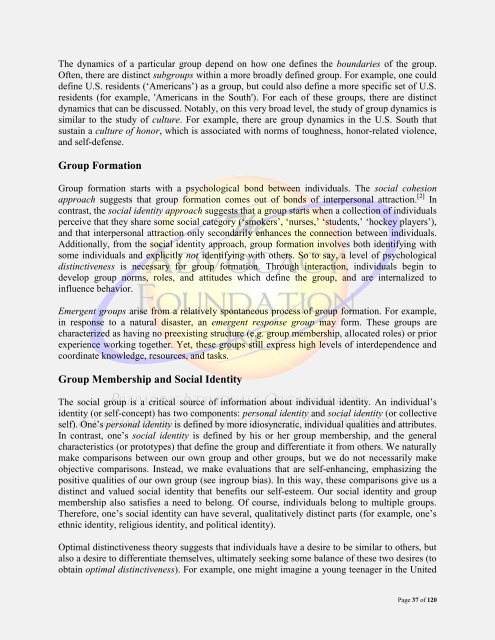Organizational Development - Vol. V, Part II
Organizational Development - Vol. V, Part II
Organizational Development - Vol. V, Part II
Create successful ePaper yourself
Turn your PDF publications into a flip-book with our unique Google optimized e-Paper software.
The dynamics of a particular group depend on how one defines the boundaries of the group.<br />
Often, there are distinct subgroups within a more broadly defined group. For example, one could<br />
define U.S. residents (‗Americans‘) as a group, but could also define a more specific set of U.S.<br />
residents (for example, 'Americans in the South'). For each of these groups, there are distinct<br />
dynamics that can be discussed. Notably, on this very broad level, the study of group dynamics is<br />
similar to the study of culture. For example, there are group dynamics in the U.S. South that<br />
sustain a culture of honor, which is associated with norms of toughness, honor-related violence,<br />
and self-defense.<br />
Group Formation<br />
Group formation starts with a psychological bond between individuals. The social cohesion<br />
approach suggests that group formation comes out of bonds of interpersonal attraction. [2] In<br />
contrast, the social identity approach suggests that a group starts when a collection of individuals<br />
perceive that they share some social category (‗smokers‘, ‗nurses,‘ ‗students,‘ ‗hockey players‘),<br />
and that interpersonal attraction only secondarily enhances the connection between individuals.<br />
Additionally, from the social identity approach, group formation involves both identifying with<br />
some individuals and explicitly not identifying with others. So to say, a level of psychological<br />
distinctiveness is necessary for group formation. Through interaction, individuals begin to<br />
develop group norms, roles, and attitudes which define the group, and are internalized to<br />
influence behavior.<br />
Emergent groups arise from a relatively spontaneous process of group formation. For example,<br />
in response to a natural disaster, an emergent response group may form. These groups are<br />
characterized as having no preexisting structure (e.g. group membership, allocated roles) or prior<br />
experience working together. Yet, these groups still express high levels of interdependence and<br />
coordinate knowledge, resources, and tasks.<br />
Group Membership and Social Identity<br />
The social group is a critical source of information about individual identity. An individual‘s<br />
identity (or self-concept) has two components: personal identity and social identity (or collective<br />
self). One‘s personal identity is defined by more idiosyncratic, individual qualities and attributes.<br />
In contrast, one‘s social identity is defined by his or her group membership, and the general<br />
characteristics (or prototypes) that define the group and differentiate it from others. We naturally<br />
make comparisons between our own group and other groups, but we do not necessarily make<br />
objective comparisons. Instead, we make evaluations that are self-enhancing, emphasizing the<br />
positive qualities of our own group (see ingroup bias). In this way, these comparisons give us a<br />
distinct and valued social identity that benefits our self-esteem. Our social identity and group<br />
membership also satisfies a need to belong. Of course, individuals belong to multiple groups.<br />
Therefore, one‘s social identity can have several, qualitatively distinct parts (for example, one‘s<br />
ethnic identity, religious identity, and political identity).<br />
Optimal distinctiveness theory suggests that individuals have a desire to be similar to others, but<br />
also a desire to differentiate themselves, ultimately seeking some balance of these two desires (to<br />
obtain optimal distinctiveness). For example, one might imagine a young teenager in the United<br />
Page 37 of 120

















